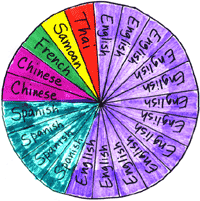 2005-2006 Class Statistics
2005-2006 Class StatisticsMs. Surber’s 2005–2006
Class
4th Grade, Barron Park School
 2005-2006 Class Statistics
2005-2006 Class StatisticsOn September 9, 2005, we recorded interesting facts about our class that were displayed in 86 bar graphs and Venn diagrams in our room.
Here are some examples of the charts and graphs we used to collect and display our data. This Venn diagram shows our lateral dominance. This bar graph illustrates our favorite instruments, and this one shows our arm spans. This circle graph (pie chart) shows the languages we speak at home.
Pairs of students in our class will create portraits of Patternoids (creatures composed of geometric shapes) and wrote descriptions of the Patternoids. Students in our partner class at Escondido will tried to re-create our Patternoids after reading our descriptions while we did the same for theirs. Then we compared the original Patternoids portraits with the recreations and evaluated our descriptions. Visit our Patternoids webpages to see the results.
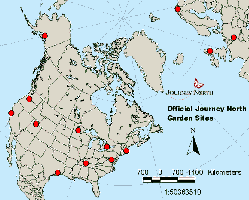 We
will join classrooms all across the Northern Hemisphere in a telecommunication
project to track the progress of spring by observing the emergence of tulips.
Our class will serve as one of the 13
Official Journey North Tulip Gardens.
Our first activity was predicting what
order the 13 Official Tulip Gardens would bloom. Students used three main strategies
for deciding which locations would experience spring first: spring would come
later to latitudes closer to the North Pole, for locations at the same latitude
those nearer an ocean would bloom first, and personal experience with climate
in locations close to the official gardens. Our class prediction:
We
will join classrooms all across the Northern Hemisphere in a telecommunication
project to track the progress of spring by observing the emergence of tulips.
Our class will serve as one of the 13
Official Journey North Tulip Gardens.
Our first activity was predicting what
order the 13 Official Tulip Gardens would bloom. Students used three main strategies
for deciding which locations would experience spring first: spring would come
later to latitudes closer to the North Pole, for locations at the same latitude
those nearer an ocean would bloom first, and personal experience with climate
in locations close to the official gardens. Our class prediction:
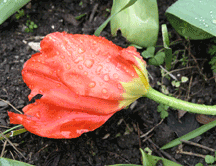 To
begin our Tulip Project, each student measured
the circumference of a tulip bulb, weighed
it, and
then predicted when that bulb would emerge and bloom in relation to the rest
of the class bulbs. The range of the circumference of our bulbs was from
110 to 140 mm; most of our bulbs were between 120 and 135 mm. The range of
the weight of our bulbs was from 20 to 41 grams; most of our bulbs weighed
30 grams or less. We made sketches
of our bulbs (more sketches)
and learned about the parts of the bulb. We dug
six inch holes, planted, and watered our bulbs on December 5th. The weather was sunny and the temperature was 56° F.
(Here is our
data form at the Journey North website.) Since the
squirrels think our tulips bulbs make tasty snacks, we protect our planter
box with a squirrel
guard.
On January 27th, we observed that
our first tulips
had emerged; here is our data
report.
You can track the progress of spring (measured by the blooming tulips) by looking
at the weekly
maps. Our first tulip bloomed on
March 22nd though it was still raining and
raining; here is our data
report.A
description of our Tulip Project is featured in Intel’s
An Innovation Oddessy. I also wrote the unit plan for Intel’s
Innovation in Education: The
Wave of Spring.
To
begin our Tulip Project, each student measured
the circumference of a tulip bulb, weighed
it, and
then predicted when that bulb would emerge and bloom in relation to the rest
of the class bulbs. The range of the circumference of our bulbs was from
110 to 140 mm; most of our bulbs were between 120 and 135 mm. The range of
the weight of our bulbs was from 20 to 41 grams; most of our bulbs weighed
30 grams or less. We made sketches
of our bulbs (more sketches)
and learned about the parts of the bulb. We dug
six inch holes, planted, and watered our bulbs on December 5th. The weather was sunny and the temperature was 56° F.
(Here is our
data form at the Journey North website.) Since the
squirrels think our tulips bulbs make tasty snacks, we protect our planter
box with a squirrel
guard.
On January 27th, we observed that
our first tulips
had emerged; here is our data
report.
You can track the progress of spring (measured by the blooming tulips) by looking
at the weekly
maps. Our first tulip bloomed on
March 22nd though it was still raining and
raining; here is our data
report.A
description of our Tulip Project is featured in Intel’s
An Innovation Oddessy. I also wrote the unit plan for Intel’s
Innovation in Education: The
Wave of Spring.
We will collect monthly data about Matadero Creek this year. Our first Creek Observation was on Thursday, September 1st. You can see our data on our Matadero Creek Data page.
Passport to California and Suitcase Presentations: We enjoyed hearing the stories of how our families came to California. Here is the data about the arrival of our families in California:
| When | Who | From Where | Journey | Why |
|---|---|---|---|---|
| 1870 | Camille | Lexington, Kentucky | covered wagon, 4 months | new life |
| 56 Years Later | ||||
| 1926 | Ms. Surber | West Brook, Texas (via Colorado) | truck, 3 years | good farmland |
| 29 Years Later | ||||
| 1955 | Rebecca | Chicago, Illinois | plane, 8 hours | new job |
| 2 Years Later | ||||
| 1958 | Madeline | Kokomo, Indiana | car, 1 week | exciting place to live |
| 2 Years Later | ||||
| 1960 | Amoriah | Amsterdam, Holland | plane, 9 hours | warmer climate |
| 9 Years Later | ||||
| 1969 | Erica | Hong Kong | plane, 1 day | better life & job |
| 6 Years Later | ||||
| 1975 | Alex L | Hong Kong | plane, 17 hours | better education |
| 4 Years Later | ||||
| 1979 | Kyle | Hong Kong | plane, 13 hours | education |
| 1980 | Benjamin | Bangkok, Thailand | plane, 16 hours | better life |
| 3 Years Later | ||||
| 1983 | Ariana | Lockport, New York | plane, 8 hours | job |
| 1984 | Eli | Providence, Rhode Island | plane, 10 hours | job |
| 5 Years Later | ||||
| 1989 | Moira | Chicago, Illinois | car, 6 days | job |
| 2 Years Later | ||||
| 1991 | Julian | France | plane, 10 hours | join friends |
| 2 Years Later | ||||
| 1993 | Brian | Lima, Peru | plane, 10 hours | better future |
| 1994 | Jonnatan | Michoacan, México | plane, 3 hours | new job |
| 1995 | Lily | Michoacan, México | bus & plane, 2 days | better job |
| 1996 | Alex Z | Rioja, Peru | plane & train & bus & car, 1 month | sick relative |
| 4 Years Later | ||||
| 2000 | Rachel | North Carolina | plane, 2 hours | new job |
| 2001 | Corentin | Grenoble, France | plane, 14 hours | new job |
| 2002 | Talia | Arkadelphia, Arkansas | car & bus, 6 days | graduate school |
| 2003 | Alexandra | Manilla, Philippines | plane, 6 hours | job |
| 2 Years Later | ||||
| 2005 | Madison | Tucker, Georgia | plane, 5 hours | job & climate |
| Janiña | Philippines | plane, 6 hours | ||
| 2006 | Adriana | Tijuana, México | ||
California Geography: Geography is our first unit in Social Studies. We learned about latitude and longitude and how to read all types of maps of California. Our final project was to make a relief map of the our state. We sketched the major geographical features of the state of California on large boards and modeled the mountains and valleys with a goopy mixture of salt and flour. After the “goop” dried, we painted the elevations and the surrounding states. Finally we located five important cities and made a key. We agreed that this was a fun and messy project! The finished maps are quite impressive. Here are two examples and two more.
Investigating Artifacts: In the first section of this unit we walked to Bol Park to collect natural materials which we sorted and classified. We used our natural materials for a math lesson on Venn Diagrams. It was fun trying to figure out the Secret Sorting Rule of each Venn Diagram: Venn Diagram #1, Venn Diagram #2. Most were very hard to guess! Then we made masks (more masks). In the second section we listened to myths, wrote our own myths, created posters (more posters) to illustrate the myths, and shared our myths around a “campfire” in our classroom. In the final section of the unit we excavated “middens” by carefully sieving the soil, cleaning and polishing the artifacts, and recording the spot where each artifact was discovered with a sketch and a label. The completed midden maps (a second midden map & a third map) and museums (another museum) helped us draw inferences about the culture from the artifacts we found.
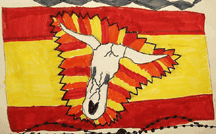 California Explorers:
Each group chose an explorer who was important in the history of California.
Students made timelines of California and placed their explorers in time, made
maps to show where the explorers traveled, drew portraits of what the explorers
might have looked like, and wrote essays about the goals and accomplishments
of the explorers. Then each group created a poster and made a presentation
to the rest of the class. Explorers we learned about:
California Explorers:
Each group chose an explorer who was important in the history of California.
Students made timelines of California and placed their explorers in time, made
maps to show where the explorers traveled, drew portraits of what the explorers
might have looked like, and wrote essays about the goals and accomplishments
of the explorers. Then each group created a poster and made a presentation
to the rest of the class. Explorers we learned about:
• Juan Bautista de Anza
• Álvar Nuñez Cabeza de Vaca
• Juan
Rodríquez Cabrillo
• Hernán Cortés
• Sir Francis Drake
Mission Period: Each student chose one of the 21 California Missions as the topic of a research report. We learned how the Spanish changed the lives of the Native Californians and wrote letters from the perspective of a Native American who had joined a mission. Our final project was creating a HyperStudio stack to publish our reports.
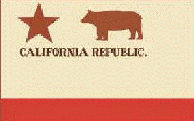 Americans
Arrive:For this period of California history, we shifted perspective
and looked at California from the American point of view. We learned about
the fur traders that opened new routes to California, and the reaction to
the news of the new land to the west they took back to the United States.
We tried to understand the hard decisions pioneers from the United States
traveling to California in wagon trains had to make along the way. Then we
studied the Bear Flag Revolt of 1846, which proclaimed California an independent
republic. The California Republic lasted for less than three weeks, but did
influence our state flag! In his memoirs, the Recuerdos (Recollections),
General Vallejo wrote, “the bear looked more like a pig than a bear.”
Americans
Arrive:For this period of California history, we shifted perspective
and looked at California from the American point of view. We learned about
the fur traders that opened new routes to California, and the reaction to
the news of the new land to the west they took back to the United States.
We tried to understand the hard decisions pioneers from the United States
traveling to California in wagon trains had to make along the way. Then we
studied the Bear Flag Revolt of 1846, which proclaimed California an independent
republic. The California Republic lasted for less than three weeks, but did
influence our state flag! In his memoirs, the Recuerdos (Recollections),
General Vallejo wrote, “the bear looked more like a pig than a bear.”
Gold Rush: The Room 17 Gold Rush was a great success! Our miners struck it rich at the Bol Park Gold fields and then spent most of their money in our gold rush town. The Miner’s Claim Company Assay Office was efficient and well organized. The Gold Rush Bank did a booming business buying gold from the miners for $16.00 an ounce. Our hungry and thirsty miners didn’t mind the high prices at the Golden Café, there was a good selection of goods at the Golden Market, and the show performed by Monkey’s Pet Radio (MPR) was hilarious.
All About Us: Our first math unit was an introductory data collection and graphing unit. We started by collecting some information about our class. We learned all sorts of interesting things about our class and organized our data with bar graphs and Venn diagrams. Here are some examples of the charts and graphs we used to collect and display our data. This Venn diagram shows our lateral dominance. This bar graph illustrates our favorite instruments, and this one shows our arm spans. This circle graph (pie chart) shows the languages we speak at home. This pictograph shows the number of Golden Trash Cans our class has earned this year.
Mathematical Thinking in 4th Grade: In our second math unit we worked on mental math skills by playing games like Close to 100 and 101-200 Bingo. We used patterns to solve related problem sets mentally. We finished this unit by creating symmetrical designs. We began by reviewing Mirror Symmetry. We created some designs that had both Mirror and Rotational Symmetry. The hardest was creating designs that had Rotational Symmetry but NOT Mirror Symmetry. Some of our Mirror Symmetry designs appeared on a flyer for a lecture on “New Ideas in Topological String Theory” at UC Berkeley.
Arrays and Shares: In our third math unit we practiced our multiplication facts through 12 x 12 and worked on multiplication and division problems.
Landmarks in the Thousands: In our fourth math unit we investigated our number system by working with problems in the 100s and 1000s. The final activity for this unit was making a 10,000 chart, which was huge!
Seeing Solids and Silhouettes: In this 3-D geometry unit we built structures from cubes and practiced visualizing and describing the objects from different points of view. We created 3-D objects from two-dimensional drawings, often a challenging task! The final project was to build a Cube Toy out of about 50 cubes and then write a packet of directions for re-creating it. Students used many strategies for helping someone build a 3-D object from flat directions. As we tested each other’s directions, we discovered the most successful strategies were a combination of words and picture, step-by-step directions, layer directions, specific directions that weren’t too long, and 3-D drawings.
Equal Shares, Different Pieces: We explored fractions in this unit. While looking at fractions as equal area divisions, we made Quilts of Fourths (more examples).
Money, Miles, and Large Numbers: We worked with decimal numbers in this unit, spending money to buy lunch in different restaurants, spending $100 to buy books for a 1st grade classroom, figuring total miles run each week, and adding and subtracting both very small and very large decimal numbers.
Area and Perimeter: In this unit we began by figuring the area and perimeter of our feet. Then we investigated the different perimeters possible for one area and the different areas possible for one perimeter by designing banquet tables and gardens.
Packages and Groups: In this unit we practiced multiplication and division with two and three digit numbers.
Sunken Ships and Grid Patterns: We learned how to do coordinate graphing in all four quadrants and how to program the computer using LOGO commands to make geometric shapes and patterns.
Appearances: Our first book has two stories linked by the theme of not judging by appearances: “Brother to the Wind” and “The Cat Who Thought She Was a Dog and the Dog Who Thought He Was a Cat.”
Island of the Blue Dolphins, by Scott O’Dell, helped us understand the life of the Chumash. We illustrated our favorite parts of the book captioned with a quote from the novel. We wrote poems using similes (a favorite literary device of Scott O’Dell) and created crayon and water color art projects featuring organisms from the book (four watercolors and four more watercolors). For our final activity we watched the movie adaptation of the book and discussed the similarities and differences.
Babe, the Gallant Pig, by Dick King-Smith, was fun to read even though the dialect was often difficult to understand. We learned many new vocabulary words about sheep herding and discovered how being brave and polite can lead to success. The final activity for this book was to create ribbons (two examples & two more & a final two examples) summarizing how each character helped Babe achieve his goal.
Literature Circles: In Literature Circles we practice and refine
the skills needed to participate in book discussions: choosing discussion
questions, leading a discussion, making connections between literature
and real life, learning new vocabulary words, identifying and appreciating
literary elements.
• Among the Hidden, by Margaret Peterson
Haddix
• Bridge to Terabithia, by Katherine Paterson
• Bunnicula, by Deborah and James Howe
• Tales of a Fourth Grade Nothing, by Judy Blume
• A Long Way from Chicago, by Richard Peck
Tato: The Barron Park 4th Grade Teachers wrote a grant to make it possible for our classes to work with an author this year. Our visiting author was Kathe Gogolewski, who has written a fantasy-adventure for children called Tato. Mrs. Gogolewski visited our class every day for a week in March, reading her book aloud, and helping us do science and math activities connected with the reading. We measured our “blind spots,” measured angles with protractors, used mirrors and different sized angles to multiply images, investigated acids and bases with Ms. Surber’s Secret Formula (red cabbage juice), and created rainbows. We had a wonderful time working with Mrs. Gogolewski!
In the Year of the Boar and Jackie Robinson, by Bette Bao Lord, helped us to understand what is was like to immigrate to the United States from China in 1947.
By the Great Horn Spoon!, by Sid Fleishman, was a funny historical fiction about a boy and his butler who traveled to the gold fields in California from Boston around Cape Horn.
 Creatures:
Our first writing assignment was to describe the imaginary creatures
created by three students working
secretly to make the different sections. Here are two
examples of our creatures, and two
more.
Creatures:
Our first writing assignment was to describe the imaginary creatures
created by three students working
secretly to make the different sections. Here are two
examples of our creatures, and two
more.
Opinion About Me: After reading An Anteater Named Arthur, by Bernard Waber, we wrote essays describing an opinion our family has about us. Like Arthur’s mother, we tried to use specific details and strong adjectives to support our topics.
Folding Books: We began our work with personal narratives by writing two short books about an event we felt strongly about. We worked on strong first sentences that “grab” the reader’s attention, and sticking to the topic.
Persuasive Essays: We wrote two essays trying to convince our audience to accept our topic statement. We worked on writing strong supporting points to prove our topic and using a variety of sentences.
Object Perspective Essays: For this essay we practiced writing from another point of view by imagining we were an inanimate object we see every day, like a stuffed bear or a pillow.
Spices: We began by learning about the Spice Trade, when explorers search for quicker routes to the spice lands. Each child chose two spices to investigate. We practiced using separate note cards to organize topics, skimming for important information, and taking notes in phrases rather than copying whole sentences from the source.
Mission Reports: Each student selected one of the 21 California missions as the subject of a research report. We practiced many report-writing skills: skimming for specific information, note taking, organizing information, presenting factual information accurately and in an interesting way, writing a bibliography. After taking notes we wrote rough and final drafts for each section. For the final draft we used a program called HyperStudio. Students learned how access the tool pallets and drawing tools to create a floor plan of the mission. When the text on a page was finished, students learned to use the painting tools to decorate the page.
Mission Letter: Each student wrote a letter from the persepective of a Native American child living at a missiion. The letter described both the advantages and disadvantages of mission life and then gave advice to an imaginary cousin about the wisdom of coming to join the mission.
Water: Our first science unit is the study of water. We observed several properties of water: surface tension, rate of flow, and expansion/contraction with changes in temperature. We observed that hot water (tinted red) floats in a glass of room temperature water while ice cold water (tinted blue) is so dense that it remains in the small vial at the bottom of the cup. (picture of experiment) We also investigated how location and surface area influence the rate of evaporation and explored condensation. Using a chemical indicator, we tested to see if water samples were hard or soft. We investigated what happens when water flows over different Earth materials, tested water from home, and conducted a blind Taste Test of five different waters. We built water wheels to experiment with the way water flows.
Magnetism & Electricity: In this unit we began by studying magnetism and experimenting with the forces of attraction and repulsion. We were amazed by how many spacers it took to break the force of attraction. We then began to experiment with electricity. We tested objects to see if they were good conductors and insulators and built a simple circuit with by a switch that controlled a motor. We discovered how to light a bulb (using just one battery, one bulb, and one wire) and explored open and closed circuits. We are getting better at tracing the flow of electricity in our heads to predict if a diagram will result in a complete circuit that will light the bulb. We learned to make schematic diagrams, using symbols to stand for the different parts of our circuits. We experimented with series and parallel circuits. With one D-cell battery we were able to light only four small bulbs wired in series. With the same D-cell battery we were able to light 12 bulbs wired in parallel. We built an electromagnet and experimented with the effect the number of times we wound the wire around the core would have on the strength of the electromagnet. Then we used our electromagnets to build a telegraph and practiced sending messages in code. As a final activity for this unit, students designed an investigation to answer a question about magnetism or electricity or are worked on a project to demonstrate something they learned. As we investigated questions, we learned how to set up experiments, how to test equipment, and how to problem-solve circuits that didn’t work the way we expected them to! Some example projects: Vaccuum Cleaner, Einstein’s Cool Math Tricks, Quiz Boards.
 Animal
Studies: In this life science unit we observed and cared for Dwarf
African Frogs, Fiddler Crabs, and Land Snails. We learned many interesting
things by watching our animals and taking accurate observational notes.
The final activity was for each group to choose a question that could
be answered by observation. Each group then presented the results of
their observations to the rest of the class. The investigation questions
were:
Animal
Studies: In this life science unit we observed and cared for Dwarf
African Frogs, Fiddler Crabs, and Land Snails. We learned many interesting
things by watching our animals and taking accurate observational notes.
The final activity was for each group to choose a question that could
be answered by observation. Each group then presented the results of
their observations to the rest of the class. The investigation questions
were:
 |
Quilts: Each student made a Crazy Quilt with a different design in each quilt piece.The finished individual quilts are displayed together in a class quilt which symbolizes all of the different personalities that are joined together into one whole classroom community. Here are four example quilts, four more, four more, four more, four more, and the last one. |
|
|---|---|---|
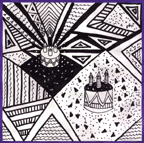 |
Camouflaged Lines: In this SPECTRA Art lesson we reviewed different kind of lines. Everyone picked a small design and created an art work around it, attempting to camouflage the original line work. We will use the designs to make covers for our sketch books. Here are four examples, and four more. Ms. Surber has a great time when Erna teaches SPECTRA lessons since she gets to make one too! |
|
 |
Island of the Blue Dolphins: After reading Island of the Blue Dolphins, by Scott O’Dell, we created crayon and watercolor pieces depicting symbols from the book. We divided our paper into sections with crayon, and used a template to make our larger designs. Here are four examples and four more. | |
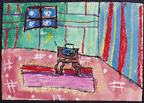 |
Matisse and Patterns: In this SPECTRA Art lesson we looked at works by Henri Matisse, noting the use of patterns in his work. Our paintings started with pastel drawings of a table, something on the table (like a fish bowl or flowers) or under the table (like a dog). Then we drew lines to divide the room and added a window. We used different patterns in each section and then finished with watercolors. Here are four examples and four more. | |
 |
Cyanotypes: We toured Romancing the Shadows, an exhibition of contemporary photographic work created with historic processes including daguerreotype, tintype, pinhole photographs, and palladium prints. Then we created our own cyanotypes, a historic photographic process in which objects on chemically-treated cloth are exposed to sunlight, turning the cloth a deep blue. Here are four examples and four more. | |
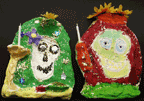 |
Day of the Dead Shrines: In this SPECTRA Art lesson we learned about the Day of the Dead and then made shrines out of clay. Later we painted our shrines with bright colors and added candles and flowers. Here are two examples, two more, and a final two. | |
 |
Explorer Portraits: We made portraits using pen and watercolor while studying explorers important to the history of California. For some of the explorers we had to use our imaginations since no one know what they really looked like. Here are portraits of Juan Bautista de Anza, Álvar Nuñez Cabeza de Vaca, Juan Rodríquez Cabrillo, Hernán Cortés, and Sir Francis Drake. | |
 |
Trees: In this SPECTRA Art lesson we first painted our tree trunks, trying to create interesting negative spaces between the branches. We scratched the bark pattern with the handle of our paintbrush. Then we mixed colors and painted each negative space a different color. Here are two examples, two more, two more, and one final tree. | |
 |
Silhouettes: While studying 3-D geometry we learned to recreate a 3-D building by looking at the silhouette of the front, side, and top view. To help us understand how silhouettes work, we made silhouettes of ourselves. Here are two examples, two more, two more, and a final two. | |
 |
Elephants & Mice: This SPECTRA Art lesson is based on Seven Blind Mice by Ed Young. First we made black crayon rubbings of various textures and cut that paper into an elephant shape. Then we made a mouse stencil and used chalk or paint to add seven mice to our elephant. Here are four examples, and four more. | |
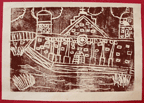 |
Mission Prints: We sketched our missions, used carbon paper to reverse our sketches, traced the carbon paper onto foam board, and then printed with brayers and block printing ink. This was a long and messy project, but the prints were amazing! Here are four examples and four more. | |
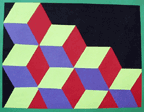 |
Cubes: In this SPECTRA Art lesson we learned about the art of Victor Vasarely and then used our 3-D math skills to build cubes out of parallelograms. Here are four examples and four more. | |
 |
Diego Rivera: For two weeks our class studied the art of Diego Rivera though the “Meet the Masters” program. One Friday the Meet the Masters teacher, showed us many prints of Diego Rivera’s beautiful paintings and murals. The prints stayed in our class for a week so that we could look at them closely. The next Friday we learned to use a viewfinder square to choose a detail to enlarge from “The Great City of Tenochtitlan,” a fresco Mr. Rivera painted in 1945 in the National Palace in Mexico City. The real mural is 16 feet high and 32 feet long! It was hard to chose just one detail since the whole mural is so interesting. Here are two examples and two more. | |
 |
Action Figures: In this SPECTRA Art lession we learned about the African-American artist, Jacob Lawrence, and looked at his work, noting the flat blocks of color and figures in action. Then we drew one action figure and used it as a stencil to make several crayon figures. Next we used watercolor to create a multi-colored background. The final step was to make one last figure with details to place in the foreground of our piece. Here are four examples and four more. | |
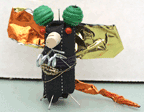 |
Assemblage Sculptures: In preparation for our Project Look field trip we discussed texture and abstraction in drawing and sculpture. We learned the vocabulary necessary to discuss sculptural art and learned how to make a sculpture that doesn’t fall down. Then we took a field trip to the Pallo Alto Art Center to see two exhibits—Robert Brady: Sculpture 1989-2005 and Deborah Barrett: Wildlife. After learning about the art on display, we created assemblage sculptures. Here is the first group, the second group, and the final group. | |
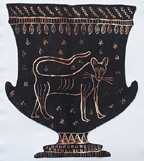 |
Greek Vases: In this SPECTRA Art lesson we began by looking at the various shapes and decorative designs of classical Greek vessels. We then cut a vase shape from tag board and applied a heavy layer of orange and beige pastels. We put a heavy layer of black and brown pastel on top of the colored layer. We then scratched a design telling a story through the layers of pastel. Here are four examples and six more. |
Stuffed Animal Day: December 1st was Stuffed Animal Day; 56 animals came to Room 17 for the day!
Crazy Hat or Hair Day: On January 13th, Barron Park School was full of students and adults showing their school spirit by appearing in a crazy hat or with crazy hair!
Career Day: January 26th was Career Day and Room 17 was full of doctors, singers, scientists, cowboys, and many other interesting careers!
100th Day of School: On February 7th we did lots of activities with 100 to celebrate the 100th Day of School. All of our math problems featured the number 100. Lots of people wore 100 things: stripes (Janiña, Erica, Ms. Surber), stripes & stars (Moira), stripes & diamonds (Rachel), stitches (Alexandra), sparkles (Amoriah), blue patches (Kyle), tie dye stripes (Talia), flowers (Madison), holes (Maddie). Many of us brought 100 things to eat: trail mix (Moira, Ms. Surber), raisins (Corentin), kumquats (Moira), Cheerios (Rachel), crackers (Eli, Maddie), peanuts (Brian). These students earned certificates for being at school on time for 100 Days: Alexandra, Talia. We also explored how much more one million is than one hundred. We counted tea tags by groups. The total for the class was 991. We figured that we still needed 999,009 to get to one million. And if we keep collecting tea tags at the same rate, it will take us about 1000 years to get to 1,000,000! One million is a LOT more than one hundred!
 Read
Across America & Pajama Day: On March 2nd we celebrated reading by reading to ourselves and each other for most of the day
while lounging comfortably in our pajamas!
Read
Across America & Pajama Day: On March 2nd we celebrated reading by reading to ourselves and each other for most of the day
while lounging comfortably in our pajamas!
Backwards Day: On March 23 we had fun doing things Sdarwkcab!
Beach Day: On May 17th we celebrated the end of STAR testing by wearing our beach clothes, picnicking on the lawn, playing with beach balls, and eating popsicles.
Website for Ms. Surber’s Current Class